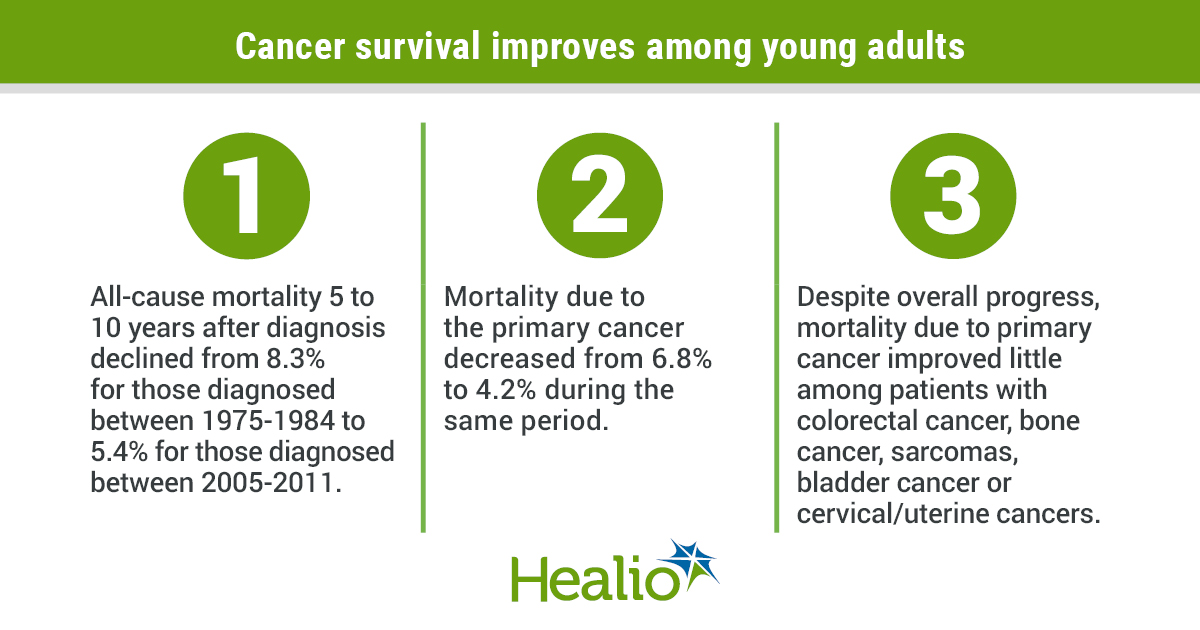Mortality rates decline among adolescent, young adult cancer survivors

All-cause and cancer-specific mortality rates have declined overall among adolescent and young adult cancer survivors during the past 4 decades, according to results of a retrospective study published in Journal of the National Cancer Institute.
However, for some cancer types — such as colorectal and bladder cancers — researchers observed little difference in late mortality since the 1970s.
“Our findings demonstrate that, although there has been substantial progress over the past few decades, there are still areas for potential improvement in [adolescent and young adult] cancer outcomes,” Chelsea Anderson, PhD, postdoctoral fellow in the behavioral and epidemiology research group at American Cancer Society, told Healio. “There are undoubtedly multiple reasons why late mortality has decreased for some adolescent and young adult cancers but not others. However, we know [that these patients] overall tend to have relatively low enrollment in clinical trials, and this may be among the factors contributing to the lack of improvement for some cancer types in this age group.”
Cancer treatment for adolescents and young adults aged 15 to 39 years has evolved substantially over the past 4 decades, leading to improvements in estimated 5-year survival. However, few studies have evaluated late mortality among this population.

Anderson and Hazel B. Nichols, PhD, assistant professor in the department of epidemiology at The University of North Carolina at Chapel Hill, studied mortality patterns among 282,969 adolescents and young adults in the SEER database who received a cancer diagnosis between 1975 and 2011 and survived at least 5 years after diagnosis.
The researchers examined cumulative mortality from all causes, the primary cancer, other cancers, and noncancer or nonexternal causes.
Investigators stratified patients by diagnosis period — 1975-1984, 1985-1994, 1995-2004 and 2005-2011 — and they excluded deaths by accident, suicide or homicide.
Most of the survivors were female (62.5%) and white (82.2%), and 38.4% had been diagnosed between ages 35 to 39 years. Breast cancer was the most common malignancy diagnosed from 1975 to 2004. Thyroid cancer was most common between 2005 and 2011.
Results showed all-cause mortality between 5 and 10 years after diagnosis decreased from 8.3% (95% CI, 8-8.6) among those diagnosed between 1975 and 1984 to 5.4% (95% CI, 5.3-5.6) among those diagnosed between 2005 and 2011. This included substantial declines for leukemias (28.6% to 6.6%), non-Hodgkin lymphoma (13% to 3.6%), Hodgkin lymphoma (9.1% to 3%), central nervous system tumors (25% to 17.2%), breast cancer (15.9% to 10.1%), kidney cancer (10.7% to 4.4%) and melanoma/skin cancers (5.5% to 2.9%).
Survival rates for several other cancer types — including colorectal, bone, cervical, uterine and bladder cancer, as well as sarcomas — showed little improvement.
The overall decrease in 5-year all-cause mortality between the earliest and most recent periods appeared to be driven by declines in mortality from the primary cancer (6.8% to 4.2%).
“It is important that we monitor trends in survival not only among recently diagnosed patients, but also among survivors who are several years beyond their initial cancer diagnosis,” Anderson said in a press release. “There have been substantial improvements over the past several decades for 5-year survivors, though some cancer types have not shared in these improvements. Survivors of these cancer types may therefore be priority groups for efforts to improve long-term surveillance to reduce late mortality from cancer among adolescents and young adults.”
The absence of detailed patient clinical and treatment data, treatment-related toxicities, nonlethal treatment failures and use of salvage therapies limits the utility of population-based cancer registries, and substantial investment would be required to create a comprehensive prospective adolescent and young adult cohort study, Brad H. Pollock, PhD, MPH, associate dean for public health sciences and chair of the department of public health sciences faculty at University of California, Davis, wrote in an accompanying editorial.
“Population-based cancer registries do not include lifestyle factors [and] comorbidities that develop in survivorship or patient-reported outcome measures,” Pollock wrote. “Without large, representative, detailed and accessible cohort data sources, research efforts to substantially improve therapy and long-term outcome for [adolescents and young adults] with cancer will remain hampered.” – by John DeRosier
For more information:
Chelsea Anderson, PhD, can be reached at American Cancer Society, 250 Williams St., Atlanta, GA 30303; email: chelsea.anderson@cancer.org.
Disclosures: Anderson, Nichols and Pollock report no relevant financial disclosures.
